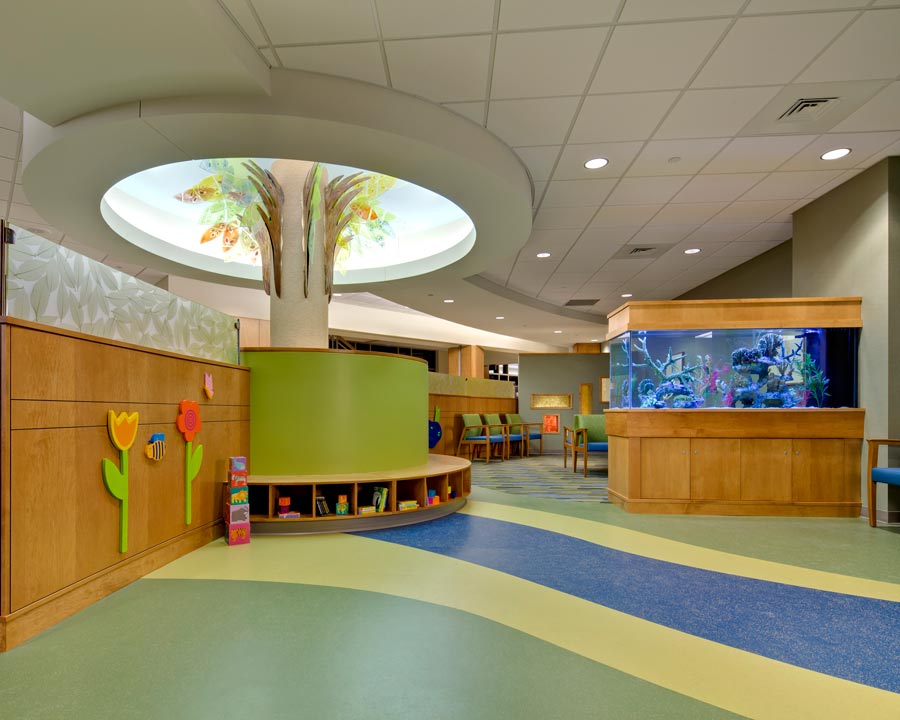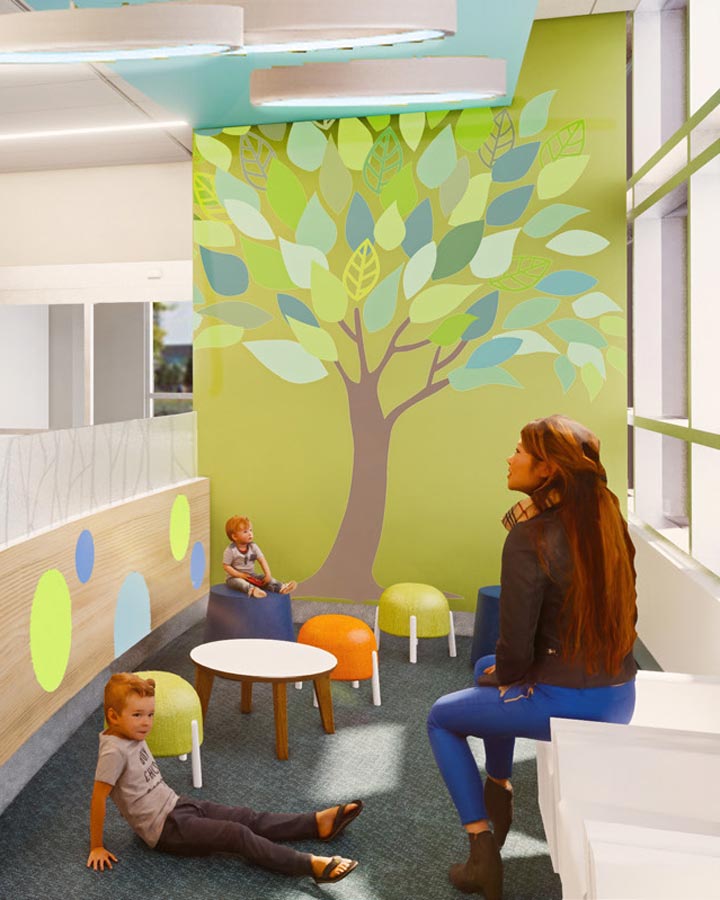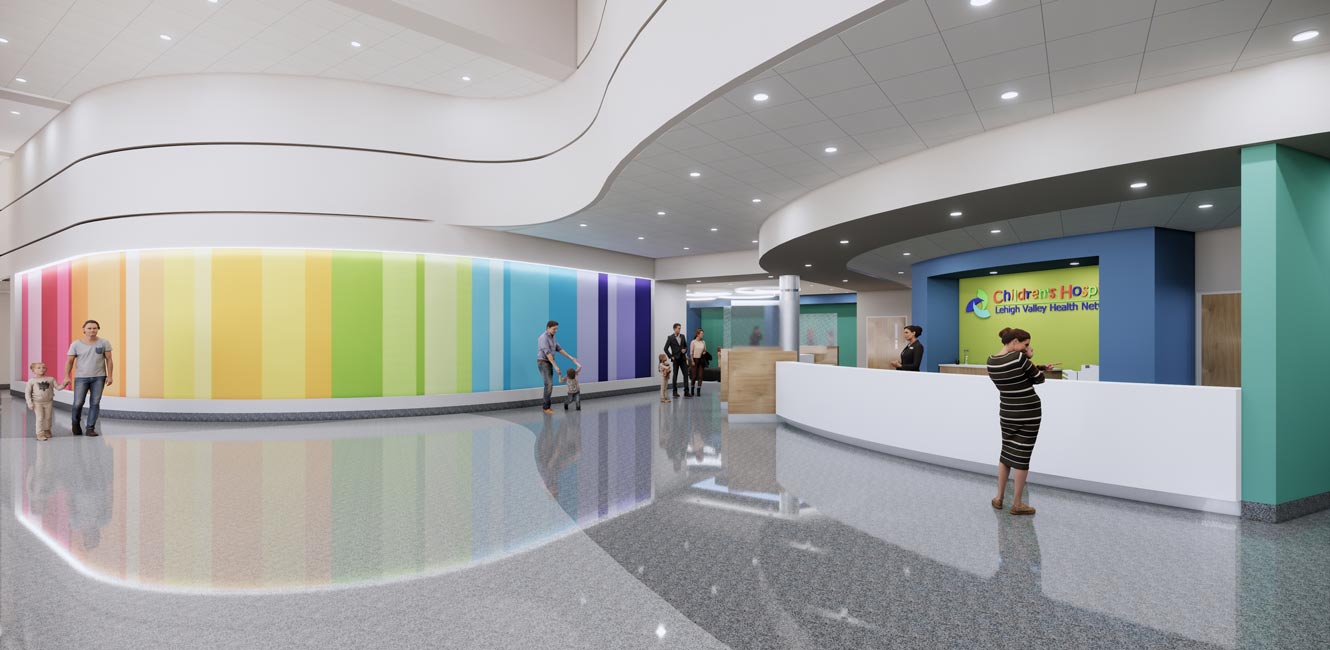What comes to mind when you think of the essence of a child? Perhaps it is boundless energy, curiosity, excitement, and imagination. Or a need for love, socialization, and safety. When designing for pediatric patients, we must take into account how to capture the wonder and playfulness of a child’s spirit. We must then translate it into spaces that meet their fundamental needs throughout the entire care experience. Outside of children, designing for the adults that accompany them, as well as facility staff and caregivers is just as important to ensure a successful care experience.
At its core, pediatric design aims to assist in the pursuit of child wellness by addressing and enhancing the needs of everyday life in the medical environments we create.
Understanding the Trifecta of Pediatric User Groups
Pediatrics encompasses ages 0-18. According to the American Board of Pediatrics, “Pediatricians practice the specialty of medical science concerned with the physical, emotional, and social health of children from birth to young adulthood” (n.d.). With such a wide developmental range, the challenge for designers is to create spaces that are fun, vibrant, and captivating, while still catering to older pediatric patients. All healthcare design requires a strong element of universality to run effectively. Yet, it should also serve as a beacon of care for an array of users. More specifically, pediatric design needs to be a place where those of varying ages, needs, and backgrounds can coexist.
While children are at the core of pediatric design, parents and guardians must not be an afterthought. The main goal of parents is to protect their children by ensuring their health and safety.

In some respects, waiting spaces must function as an extension of one’s own living room to meet the needs of everyday parenting. It is also important to provide spaces where parents can carry on the tasks of daily life such as taking a phone call or answering an email while not compromising their ability to tend to their children.
Other than the functionality of space for both the parent and child, “the welfare of children and adolescents is heavily dependent on the home and family, [while] the pediatrician supports efforts to create a nurturing environment” (American Board of Pediatrics, n.d.). Thus, parents and guardians are instrumental in creating healthy settings for their children. So, as much as pediatric visits are centered around a child’s care, educating parents is equally important. Rooms where care and instruction are administered must be designed where parents can learn and support their children with comfort and ease.
Finally, care teams must be considered in designing pediatric spaces – completing our trifecta of user groups. To do the air jobs effectively, doctors and nurses must be able to ensure the safety and wellbeing of their patients. Positive distractions and captivating environments help this charge. If environments captivate children’s curiosity and imagination, fear of a place is eased. In turn, medical staff can administer care effectively. The goal for pediatric designers is to create spaces where children are excited to go. If we are successful in this, all user groups win!
Integrative Thinking™ and Pediatric Design
Six Methods to Optimize the User Experience in Pediatric Spaces
1. Safety
Ensuring children are, and feel, safe is a top priority. As soon as children and their parents enter a facility, a sense of safety is critical to the success of a visit. This can be accomplished by creating distinct waiting spaces that are set away from high traffic areas and reception desks. This creates a controlled environment where parents can focus on their children and eliminate outside stressors.
2. Family
Creating spaces to maintain positive relationships between parents and children throughout their visit is important. If we can home in on the needs of parents specifically and provide them tools to support their children as soon as they arrive on site, designers can aid in maintaining a strong thread of trust between parents and children. The number one factor that helps us achieve this is effective wayfinding. A parent’s main objective is to focus solely on the child’s wellbeing – not wandering through a hospital’s campus. By providing clear signage and wayfinding, we help eliminate what could otherwise be an extremely stressful situation. In pediatrics, we can have some extra fun with how this is achieved. In the Lehigh Valley Children’s Emergency Department in Allentown, Penn., we indicate the point of arrival into the pediatric department with a large “Rainbow Wall” just inside the entrance. It is marked with giant rainbow-colored “Emergency” sign. The rainbow wall, along with the soffits and terrazzo floor design, curve toward the reception desk. This visual pathway takes the worry out of finding the correct point of arrival. From the hospital staff’s perspective, creating a logical flow of space and care delivery process mitigates spending time on directing visitors and allows more time for delivering care.
3. Engagement
Color, form, texture, pattern, and material create positive distractions and encourage engagement within a space. Turning artwork into an I spy game, providing educational maps, or creating interactive play spaces are just a few ways we can achieve this. By creating conversation starters between parents and children, or even children and providers, we shift some focus away from whatever brought families into the facility in the first place. Instead, creating engagement opportunities allows for other, more positive memories of pediatric experiences.
4. Zoning
Having spaces that are uniquely pediatrics, especially if designing a multiuse healthcare facility, allows children and families to relax in their surroundings. They can also escape the hum of the rest of the hospital. For example, a smaller space or series of smaller waiting spaces is more controlled. This way, we help to maintain a feeling of intimacy between parents and children. These secluded zones allow patients and parents to simply live.
5. Play
The goal for us is to minimize the disruption of daily life for patients that come through the spaces we design. By creating areas for kids to play and imagine, we are continuing the thread of creativity and minimizing the stresses of what “going to the doctor” historically means. This can also mean creating spaces that inspire active play. Active play encourages socialization among siblings and other children waiting with their families, as well as the physical activity they don’t even realize is exercise.

6. Access to Nature
The need for nature applies to all our users equally. Natural light, views to the outdoors, and biophilic design contribute to the wellbeing of all users. Biophilic design is a proven contributor to healing and the reduction of stress. “Exposure to natural elements, whether directly from nature or interpretations of it, aid in the healing process of patients… Evidence shows that representational images of natural features such as landscapes, gardens, and waterscapes can reduce stress and improve results” (Kazmierczak, 2018). Throughout the Lehigh Valley Children’s Emergency Department, we have life-sized images of sea life swimming through the care team pods. While color, pattern, and graphics can be exciting, it is also important to be mindful of other features when designing pediatric environments. Make sure that natural materials and views are prominent and balanced throughout a design. Lack of natural elements, plus the overuse of color and graphics, can be overstimulating and stressful. Balancing those “fun” elements and pops of color with natural features achieves an intriguing environment that is not stress inducing to users.
ERDMAN Takeaway

- About the American Board of Pediatrics. n.d. Retrieved from https://www.abp.org/content/about-us
- Kazmierczak, L. (2018). Nature’s Cure: How Biophilic Design Can Enhance Healing. Retrieved from https://mcdmag.com/2018/04/natures-cure-how-biophilic-design-can-enhance-healing/#.YKZ_DXmSmUl



